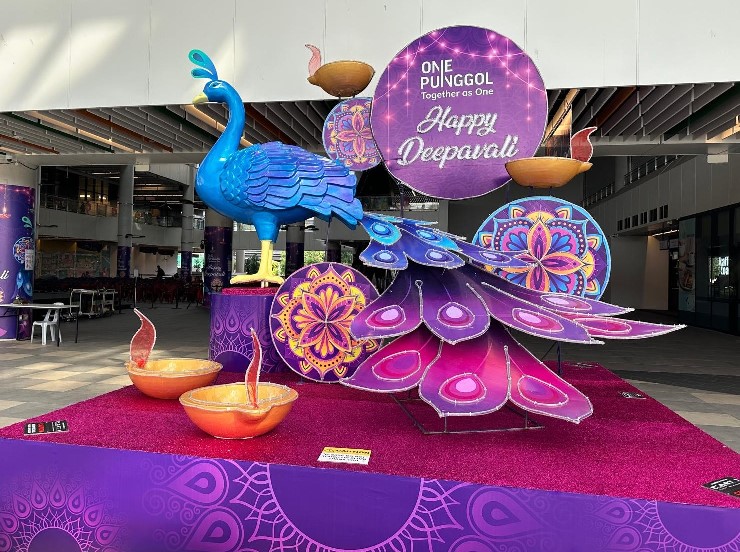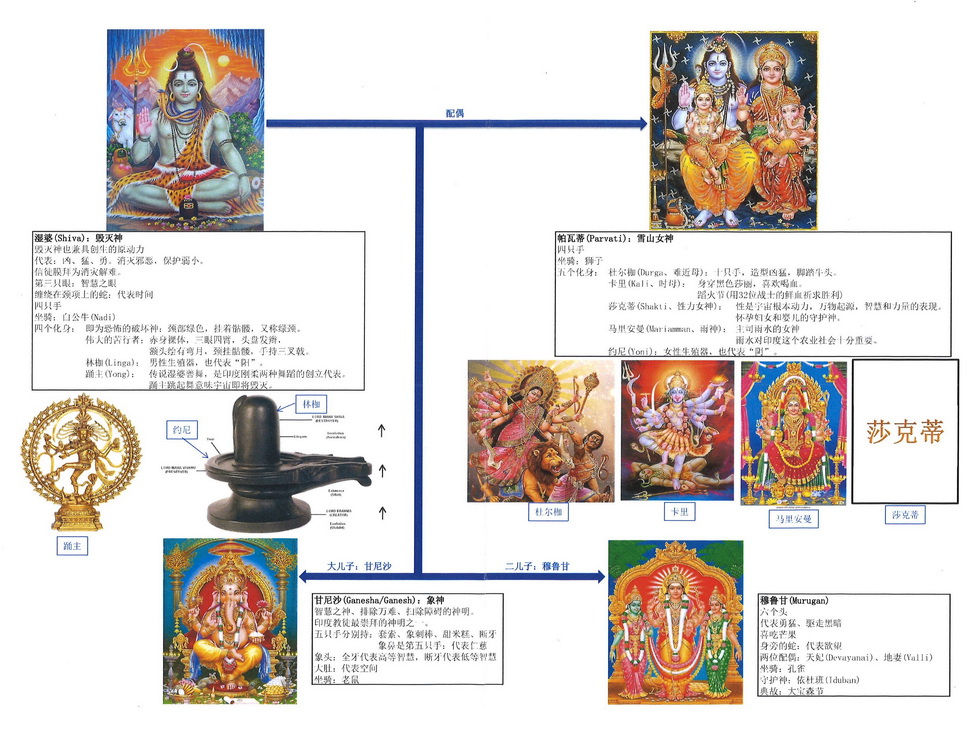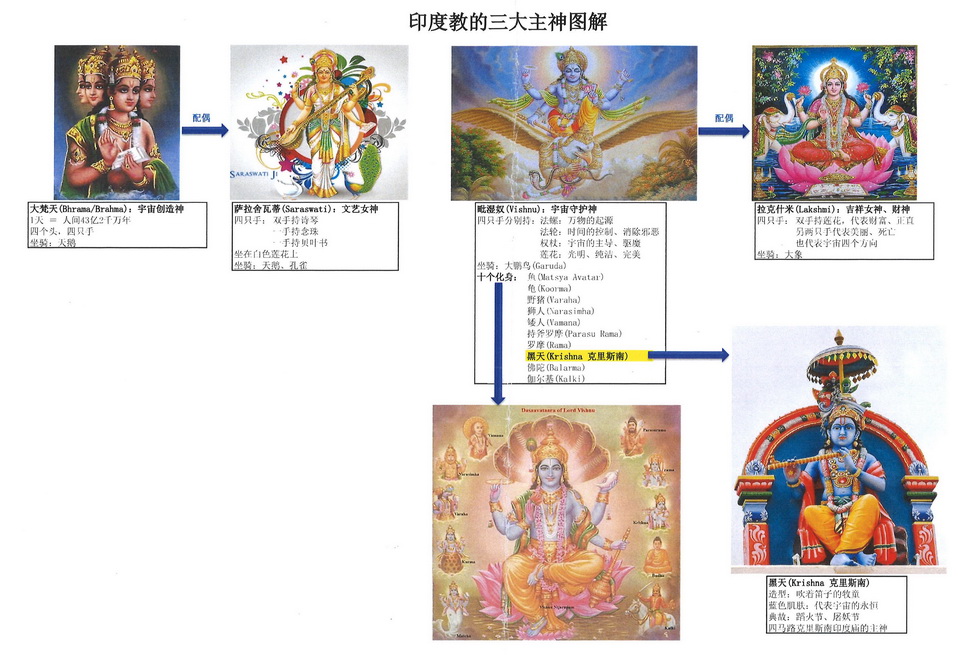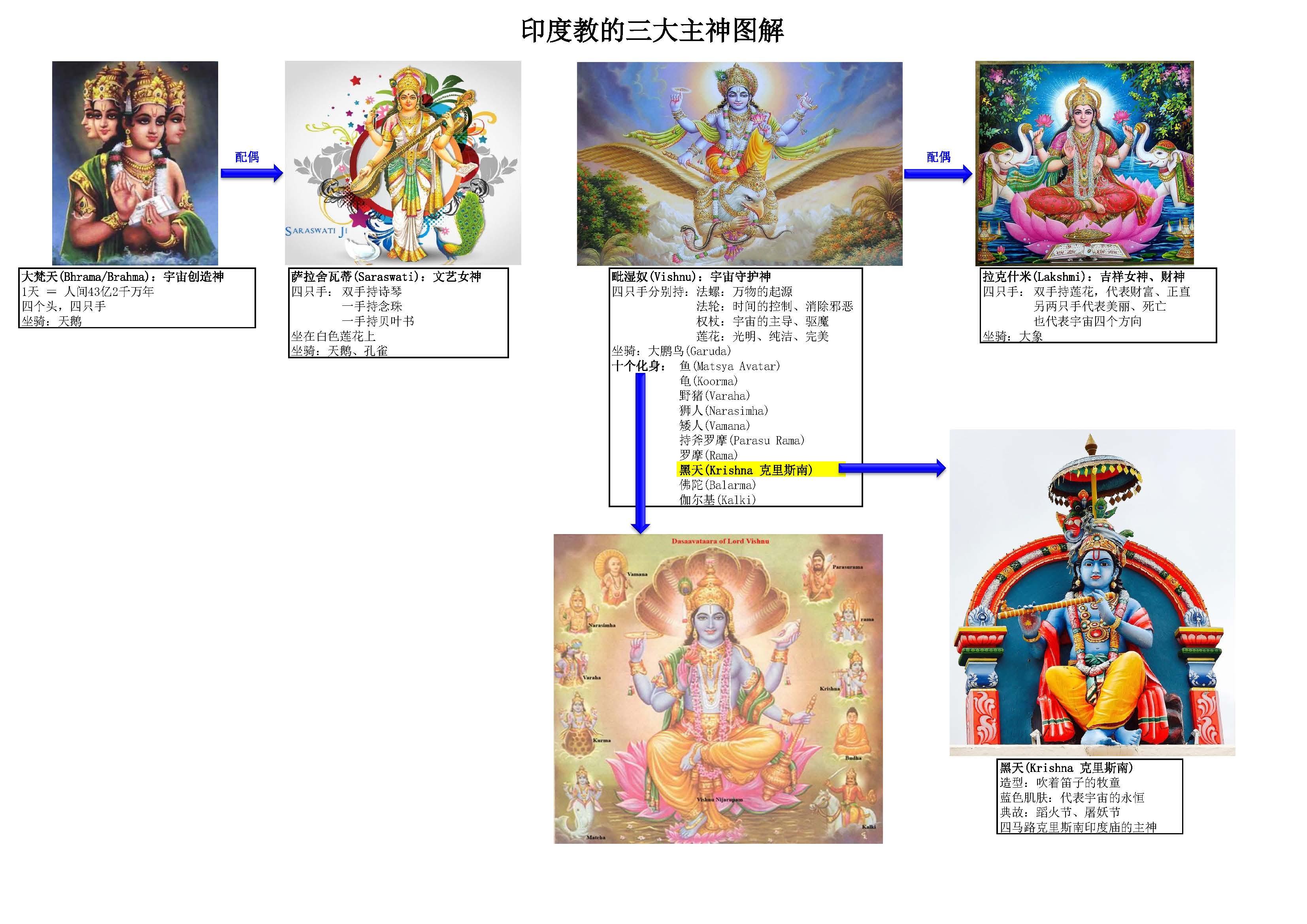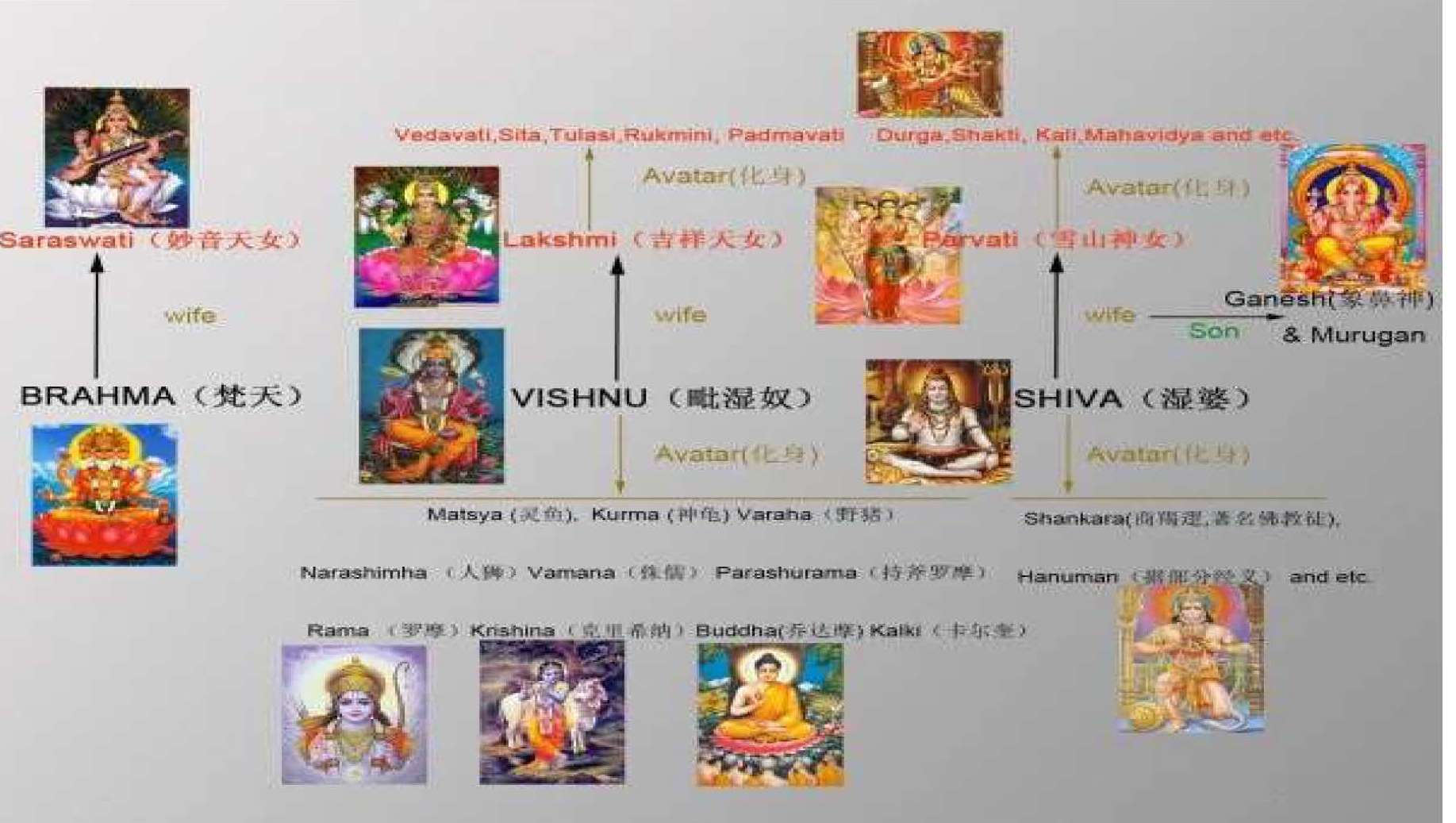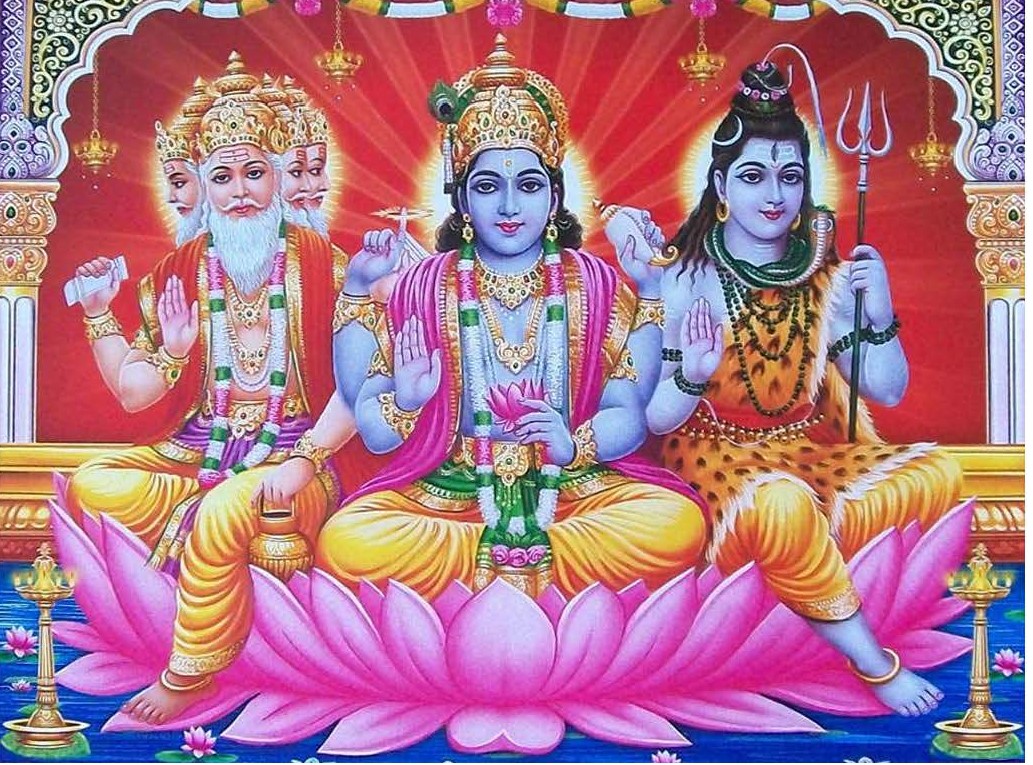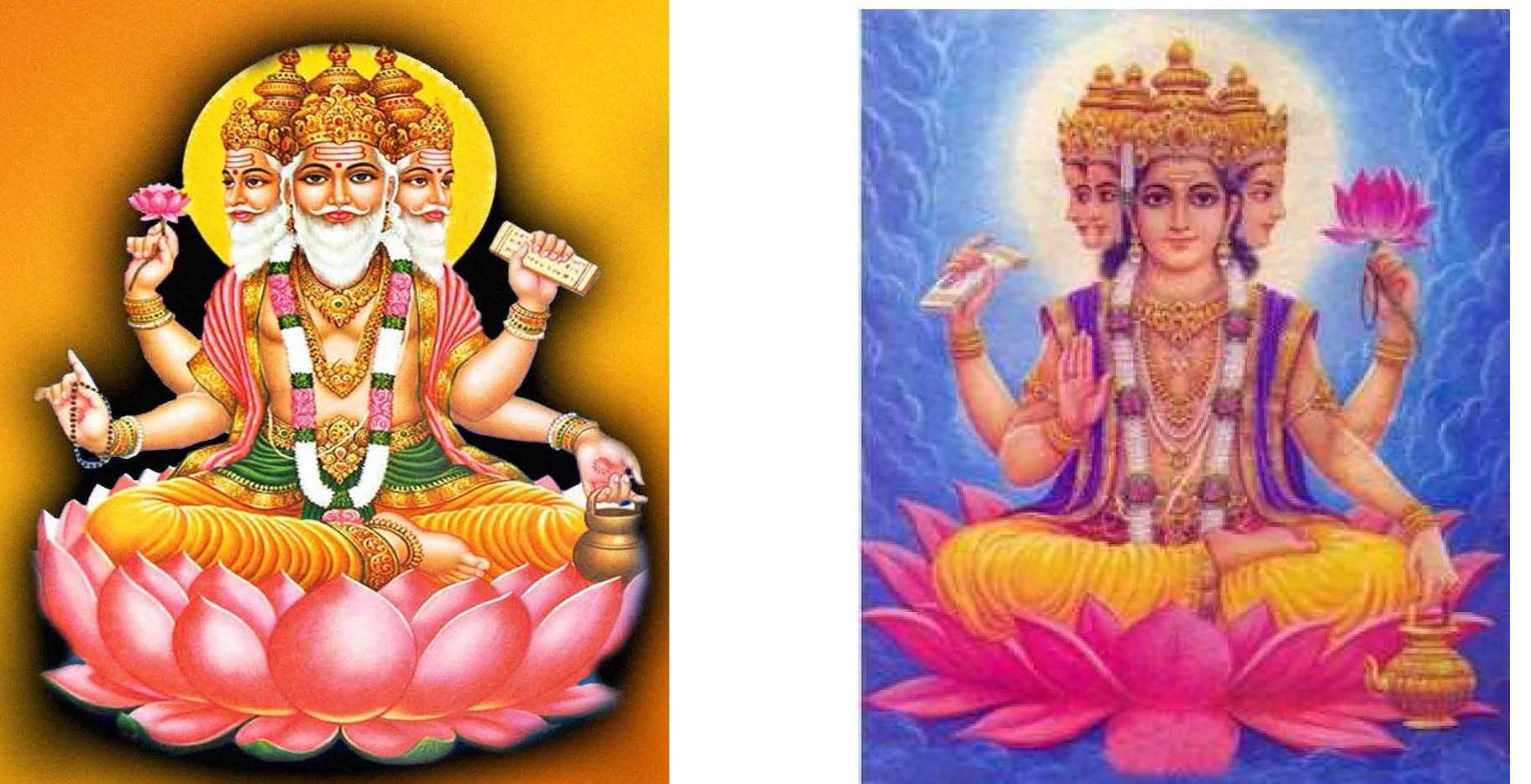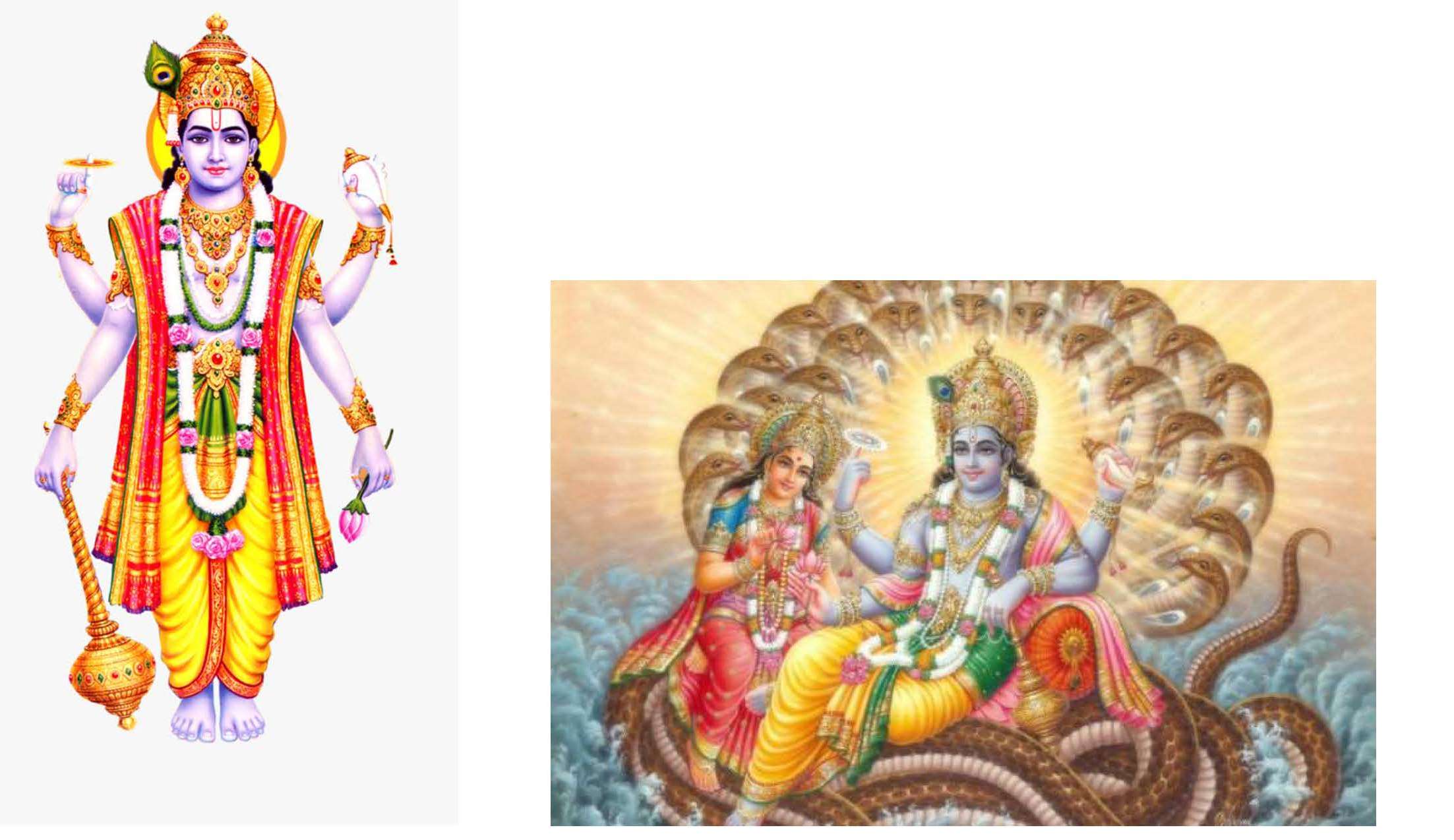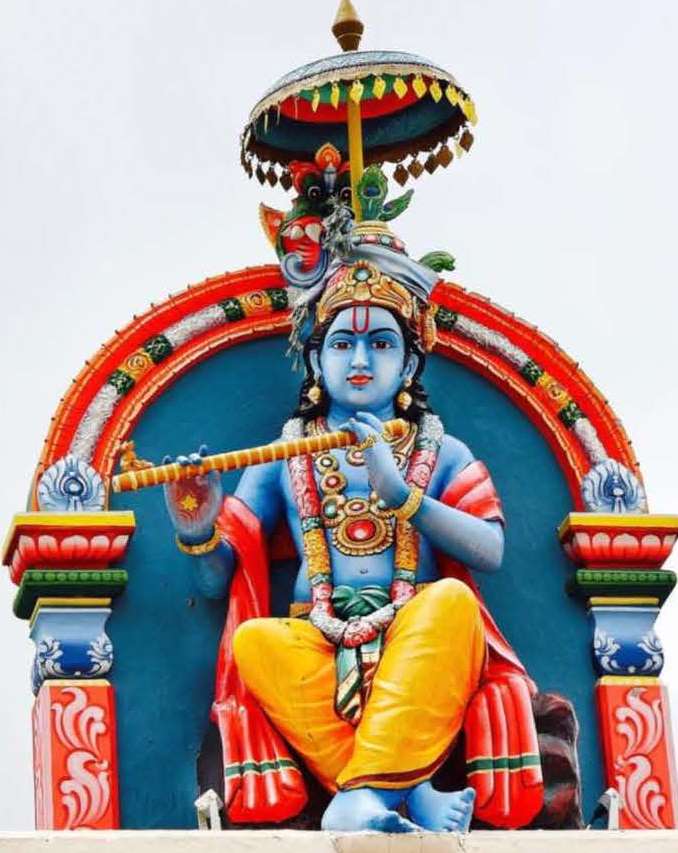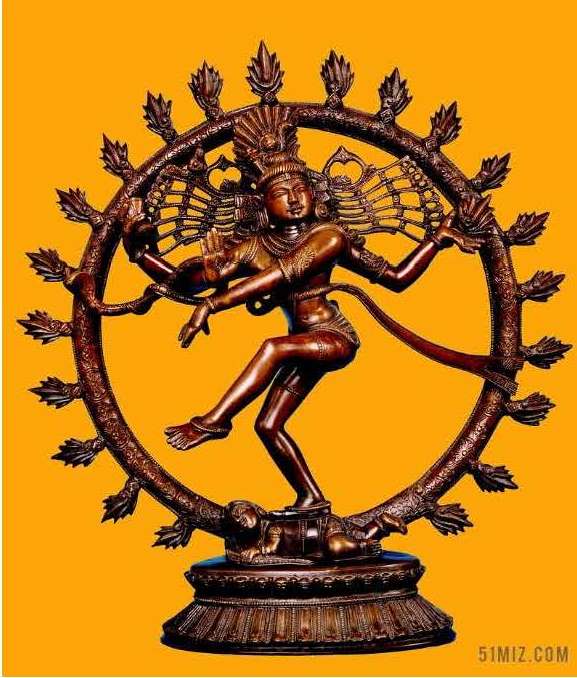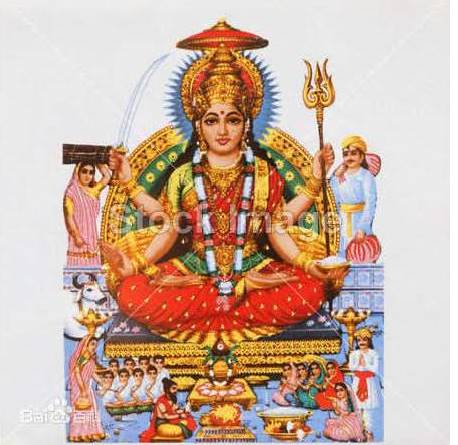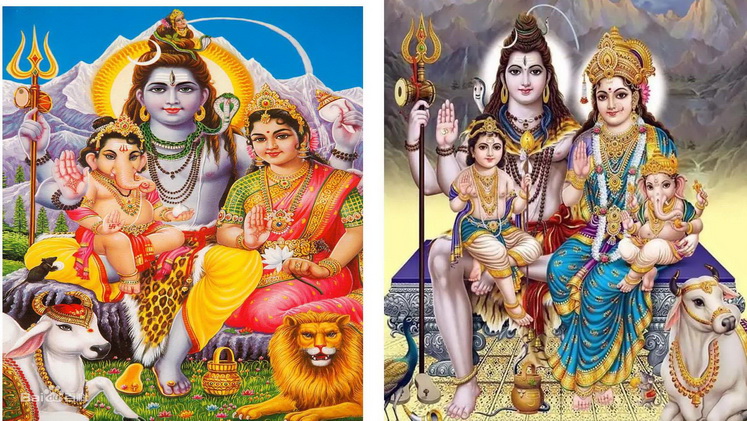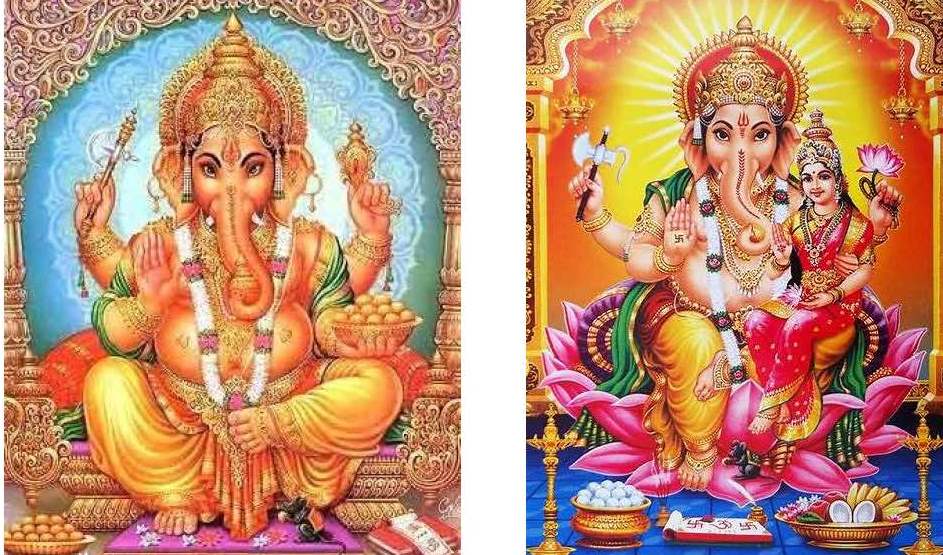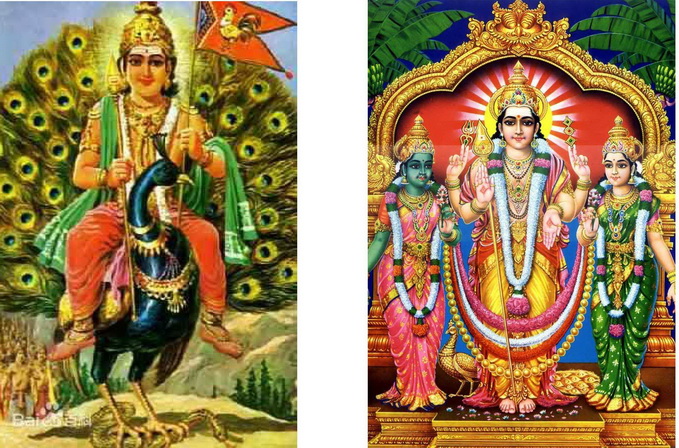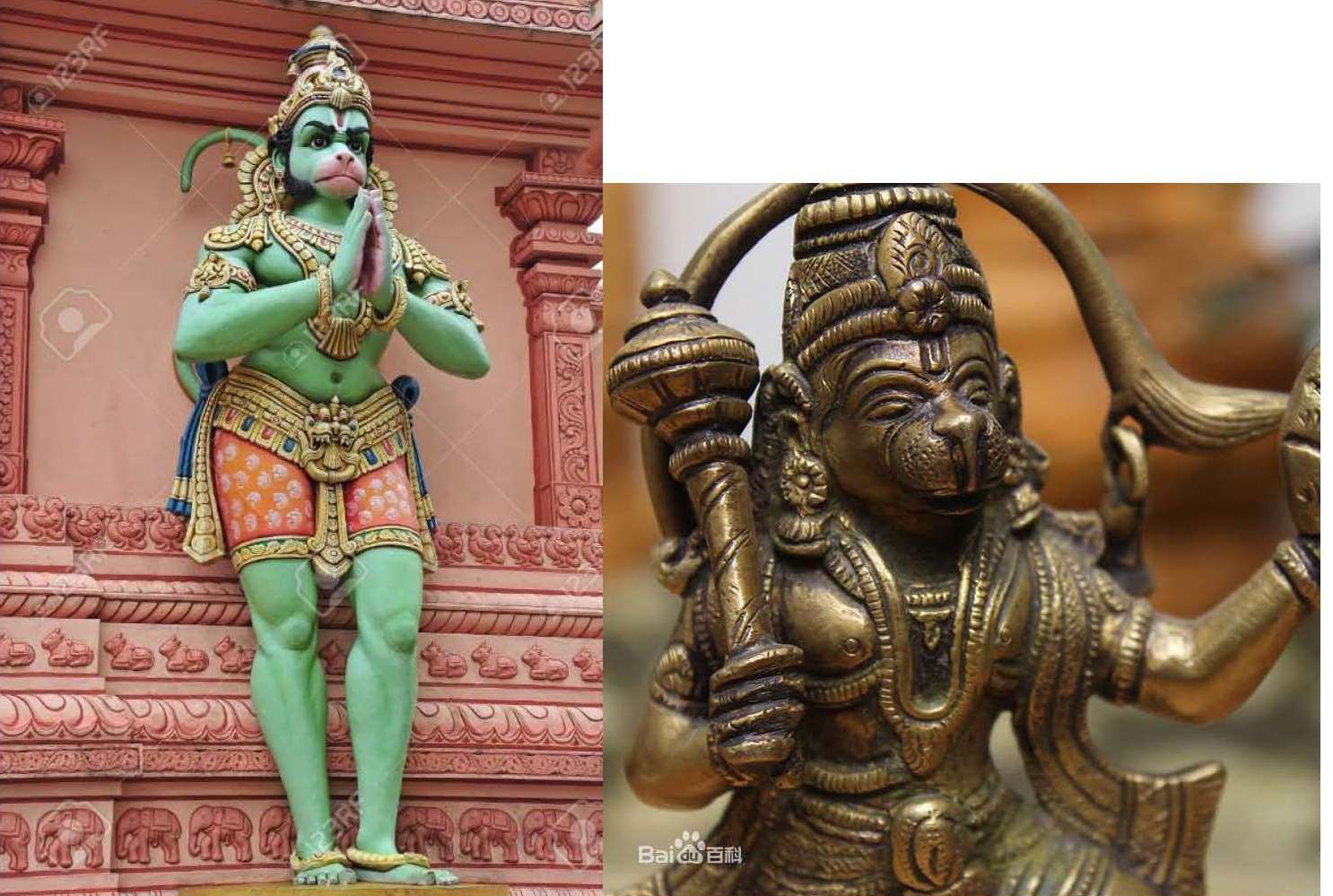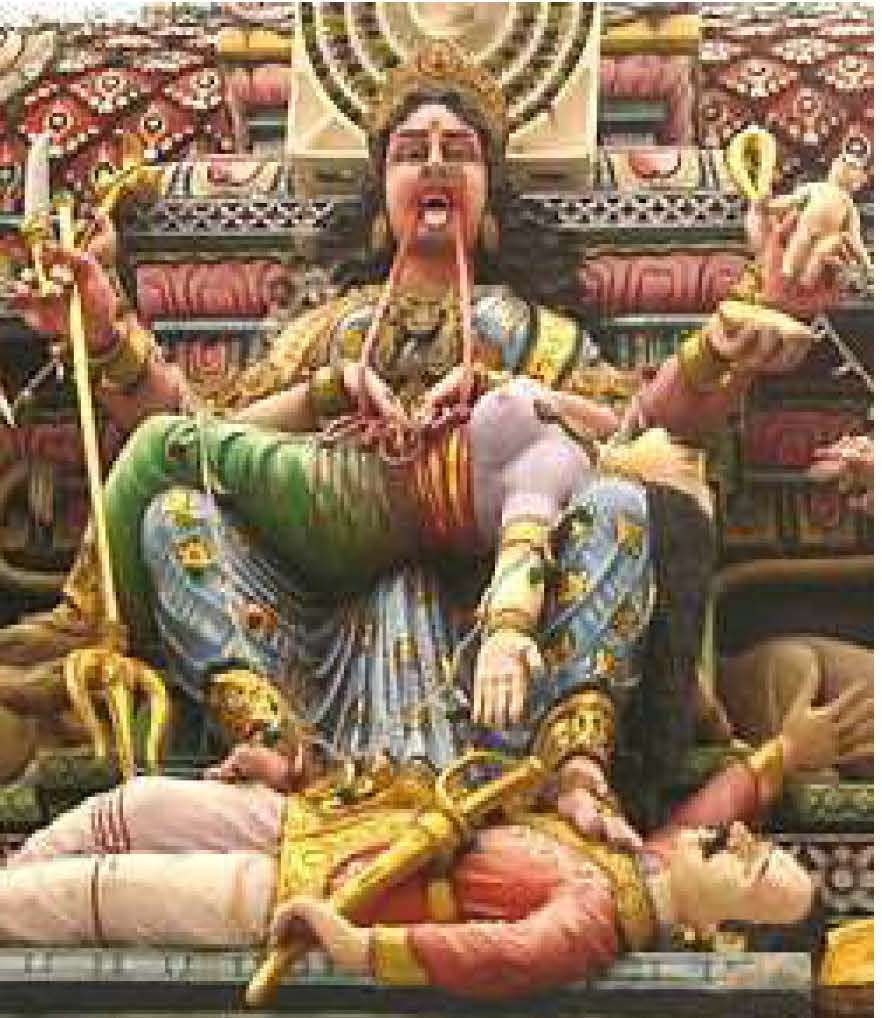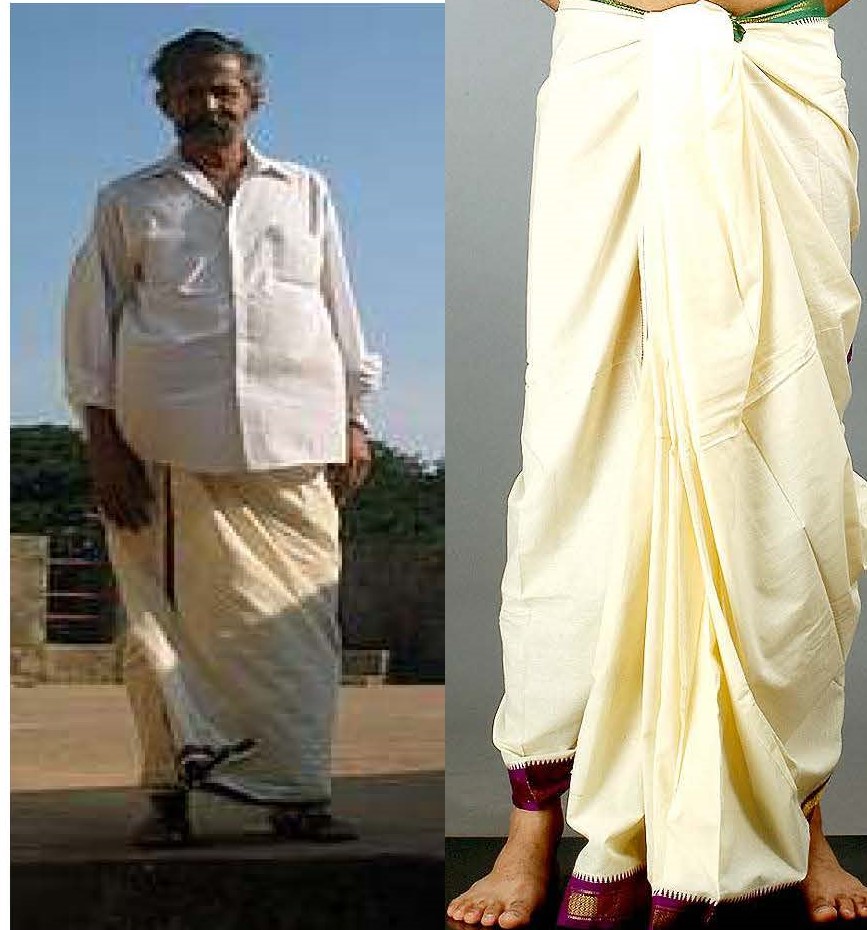INDIAN & HINDU

![]()
|
INDIAN & HINDU CULTURE
印度教徒相信有一个无形,无色又无名的至高无上的力量的存在。
自天生七国到地下七界,印度教神明共有三亿三千万。330 m 3,3000,000
是印度婆罗门教的创造之神, 1天 = 人间 43 亿 2 千万年/ 4.32 billion years
摩诃婆多罗 -罗摩衍那 Luó mó yǎn nà-薄伽梵歌Báojiāfàn gē
。 |
| GODS | CLOTHINGS | FESTIVALS | INDIAN FOOD | |
|
梵天神 (Brahma) 代表 创 造 |
毗湿奴
(Vishnu) 代 表守护 |
湿婆神 (Shiva) 代表 毁灭 |
Periyachi女神 |
|
智慧女神
Saraswati 萨拉舍瓦提 |
吉祥天女- Lakshmi 拉克什米 |
雪山女神 Parvati 帕瓦迪 |
甘尼沙
Ganesha - |
|
LITTLE RED DOT
|
Murugan - 战神 |
||
|
|
|||
|
|||||||||||||||||||
|
|
|||||||||||||||||||||||||||||
|
INDIAN GODS 所有的神明其实都代表了一个中心力量 – 婆罗门(Brahman-宇宙的精神)不过,早期的印度教为了普及平民百姓,而以多神面貌出现。
(自天生七国到地下七界,印度教神明共有三亿三千万。。。)330 MILLION GODS/DIETIES
印度教三大主神:
印度教有丰富而复杂的神话体系,涵盖了多位神祇及其家族成员。这些神祇既象征自然的力量,也代表人类的品德、情感和智慧。以下是印度教中一些主要的神祇及其家族关系:
印度教认为宇宙精神有三大功能,分别由三大神明代表: 梵天神(Brahma) —代表 创 造
毗湿奴 (Vishnu) 代 表守护
1.灵鱼摩蹉(Matsya),2.神龟俱利摩(Kurma),3.野猪筏罗诃(Varaha),4.人狮那罗辛哈(Narasimha), 5.侏儒(矮人)筏摩那(Vamana),6.持斧罗摩(Parashurama),7.罗摩(Rama),8.克里斯南(黑天)(Krishna), 9.佛陀(乔达摩·悉达多)(Buddha),10.白马迦尔吉(Kalki)
黑天(Krishna 克里斯南)造型:吹着笛子的牧童 蓝色肌肤:代表宇宙的永恒典故:蹈火节、屠妖节四马路克里斯南印度庙的
世界末日时(大梵天入睡时),由湿婆神负责毁灭整个宇宙。旧的宇宙毁灭后,新的宇宙将会创生(大梵天睡醒时
大梵天的配偶: Saraswati 萨拉舍瓦提,智慧女神,文艺女神又称辩才天女,有着除人之秽,给人后代、勇气的神力。
毗湿奴的配偶 -吉祥天女-Lakshmi 拉克什米,是婆罗门教-印度教的幸福与财富女神。
湿婆配偶 - 雪山女神 Parvati 帕瓦迪
五个化身:1.杜加尔(难近母),2.卡里(喝血的),3.莎克蒂(性力女神,得了性病摆她),4.马里安曼(雨神),约尼(女性生殖器)。
湿婆神的全家福 湿婆和雪山女神的儿子们 - 甘尼沙和穆鲁甘)
是湿婆第三只眼爆出来的火花变化成的。形象 :生有十二臂六首,为昴星团养子,坐骑为孔雀,武器为长矛,通常以童贞英俊少年形象出。他的守护神是依杜班两
印度教神话人物猴神哈奴曼
|
|||||||||||||||||||||||||||||
|
莎克蒂(Shakti、性力女神): 性是宇宙根本动力,万物起源,智慧和力量的表现。 怀孕妇女和婴儿的守护神。 |
|||||||||||||||||||||||||||||
|
潘迪亚王国曾经有一位名叫瓦拉拉拉詹·拉贾的国王,他残忍地折磨他的臣民。据说,如果他的孩子接触到地面,这一行为就会给国王带来死亡。王后临产时,国王找不到接生婆。他不得不选择一位名叫佩里亚奇的女人。这位严厉的女人成功地接生了孩子,并将孩子举起来,不让孩子接触地面。国王想杀死新生儿,以保全自己的生命。国王不知道佩里亚奇就是女神阿迪·帕拉沙克蒂,所以当她现出真面目时,他感到很惊讶。她用多只手臂将国王踩在脚下。然后,她用武器杀死了国王。与此同时,王后也想杀死婴儿,因为她认为这个孩子是她国王的死敌,但佩里亚奇杀死了王后,挖出她的胃,吃掉了她的肠子,救下了婴儿。因此佩里亚奇被称为婴儿和孕妇的保护神,据说婴儿在佩里亚奇的照顾下长大,后来成为潘迪亚国王,后来他为佩里亚奇安曼修建了许多寺庙和神社。
|
There was once a Pandya king named Vallalarajan Raja who evilly tormented his subjects. It was said that if his child touched the earth then this act would bring an end to the king. When the queen went into labour, the king could not find a mid-wife. He had to choose a woman named Periyachi. This stern woman successfully completed the delivery of the child and held it up so that it did not touch the earth. The king wanted to kill the newborn, in the intent to preserve his own life. The king did not know that Periyachi was the goddess Adi Parashakti, and so he was surprised when she took on her true form. Using her multiple arms, she trampled the king under her foot. Then, she killed the king using her weapons. At the same time, the queen also wanted to kill the baby, as she considered the child the death of her king, but Periyachi killed the queen, ripped out her stomach and ate her intestines, and saved the baby. Therefore, Periyachi was known as the protector of babies and expectant mothers. The baby is said to have grown up under Periyachi's care and later became the Pandya king, He later built many temples and shrines for Periyachi Amman. | ||||||||||||||||||||||||||||
|
哈努曼是印度神话中最受人爱戴和崇敬的人物之一,他的故事充满了英雄主义、虔诚和奇迹。哈努曼是古印度史诗《罗摩衍那》的中心人物,经常被崇拜为力量、忠诚和无私奉献的化身。下面简要复述一下他的故事: ### 出生和早年生活 哈努曼是天女 *Anjana 和猴王 **Kesari 的儿子。他的出生也归功于 **湿婆神* 的恩赐。根据神话,Anjana 曾被诅咒成为一只猴子。她虔诚地向湿婆神祈祷,寻求他的祝福来打破诅咒。湿婆对她的虔诚感到高兴,赐予她恩惠,让她生下一个拥有巨大力量和神圣品质的儿子。 在他出生的那一刻,哈努曼的神圣本性就显现出来了。年轻的哈努曼精力充沛、淘气不已,拥有非凡的力量,包括随心所欲改变体型和形状的能力。童年时期,他以顽皮的滑稽动作而闻名,经常在圣贤的修行所制造混乱,甚至试图吃掉太阳,以为那是一颗成熟的果实。 *象头神*如何折断象牙的故事是印度神话中最著名、最具象征意义的故事之一。这个故事有几个不同的版本,但最流行和最被广泛接受的版本如下: ### 跃至兰卡 哈努曼一生中最著名的一集发生在史诗《罗摩衍那》中,当时哈努曼对**罗摩神*的忠诚被揭示出来。 *阿逾陀王子罗摩被流放到森林,在流放期间,他的妻子**悉多被魔王**罗波那*绑架,带到兰卡岛(现斯里兰卡)。罗摩因失去妻子而悲痛欲绝,向*苏格里瓦*领导的猴军寻求帮助。苏格里瓦的首席将军哈努曼成为罗摩寻找悉多的重要盟友。 关键时刻到来了,哈努曼为了寻找悉多,必须穿越印度和兰卡之间的浩瀚海洋。尽管对自己的能力心存疑虑,但哈努曼对罗摩的忠诚激发了他的勇气。在神灵的启示下,他长成巨大的身躯,跃过海洋到达兰卡。这一神奇的飞跃象征着信仰和忠诚的力量。 ### 哈努曼遇见悉多 到达兰卡后,哈努曼寻找悉多。他最终在阿育王花园找到了她,她被罗波那囚禁在那里。哈努曼向她保证罗摩会来救她,并把罗摩的戒指送给她作为希望的象征。罗波那的军队抓住了哈努曼,但他没有害怕,而是利用自己的力量逃跑,他缩小了自己的体型,用燃烧的尾巴点燃了兰卡。然后他带着悉塔下落的消息回到罗摩身边,这激励罗摩召集军队去救她。 ### 战斗和在罗摩胜利中的作用 在罗摩的军队和罗波那的军队之间的史诗般的战斗中,哈努曼扮演了至关重要的角色。他表现出巨大的力量、勇气和奉献精神,以多种方式帮助罗摩和他的盟友。在最著名的一集中,当罗摩的兄弟罗什曼那受伤时,哈努曼飞到喜马拉雅山去取一种名为“桑吉瓦尼”的恢复生命的草药。他找不到它,于是把整座山带回战场,救了罗什曼那一命,并扭转了局势,使罗摩占了上风。
最后,随着罗摩战胜罗波那并救出悉多,哈努曼被誉为终极奉献者,他对主人的忠诚和爱无与伦比。 ### 哈努曼的遗产 哈努曼通常被描绘成一个猴脸人物,身体肌肉发达,手持狼牙棒(gada),有时手里拿着山或狼牙棒飞行。他象征着*奉献、**力量、**无私的服务和克服障碍的能力。在某些传统中,哈努曼被认为是湿婆的化身,因为他的力量和能量反映了神的神圣本质。 他对罗摩的忠诚被认为是虔诚的最高形式,他的壮举强调了这样一种观念:只要忠诚、信仰和谦逊,任何障碍都可以克服。
《哈努曼颂歌》是一首赞美哈努曼的赞美诗,世界各地的印度教徒广泛吟诵它,以寻求他的祝福,获得力量和保护。 ### 结论 哈努曼的故事传授了永恒的教训:忠诚的重要性、克服自我怀疑的力量,以及真正的力量在于无私地为他人服务。他对罗摩的坚定信仰,加上他非凡的力量,使他成为神圣能量、同情心和战胜邪恶的象征
|
The story of *Hanuman, one of the most beloved and revered figures in Hindu mythology, is filled with heroism, devotion, and miraculous feats. Hanuman is a central character in the **Ramayana*, an ancient Indian epic, and is often worshipped as the embodiment of strength, loyalty, and selfless devotion. Here’s a brief retelling of his story:
### Birth and Early Life
Hanuman is the son of *Anjana, a celestial nymph, and **Kesari, a monkey chief. His birth is also attributed to the grace of **Lord Shiva*. According to the myth, Anjana was once cursed to live as a monkey. She prayed fervently to Lord Shiva, seeking his blessing to break the curse. Pleased by her devotion, Shiva granted her the boon that she would bear a son who would possess immense strength and divine qualities.
At the moment of his birth, Hanuman's divine nature became evident. The young Hanuman, full of energy and mischief, had extraordinary powers, including the ability to change his size and shape at will. In his childhood, he was known for his playful antics, often creating chaos in the ashrams of sages and even trying to eat the sun, thinking it was a ripe fruit. The story of how *Lord Ganesha* broke his tusk is one of the most well-known and symbolic tales in Hindu mythology. There are a few different versions of the story, but the most popular and widely accepted one goes as follows:
### The Leap to Lanka
One of the most famous episodes in Hanuman’s life occurs during the epic story of *Ramayana, when Hanuman’s devotion to **Lord Rama* is revealed.
*Rama, the prince of Ayodhya, is exiled to the forest, and during his exile, his wife, **Sita, is abducted by the demon king **Ravana* and taken to the island of Lanka (modern-day Sri Lanka). Rama, distraught over the loss of his wife, seeks help from the monkey army led by *Sugriva*. Hanuman, Sugriva’s chief general, becomes an important ally in Rama’s search for Sita.
The pivotal moment comes when Hanuman, on a mission to find Sita, must cross the vast ocean that separates India from Lanka. Despite doubts about his own abilities, Hanuman’s devotion to Rama fuels his courage. In a moment of divine inspiration, he grows to a gigantic size and leaps across the ocean to reach Lanka. This miraculous leap is a symbol of the power of faith and devotion.
### Hanuman Meets Sita
Upon reaching Lanka, Hanuman searches for Sita. He eventually finds her in the Ashoka garden, where she is being held captive by Ravana. Hanuman reassures her that Rama will come to rescue her, and he gives her Rama’s ring as a token of hope. Ravana’s forces capture Hanuman, but instead of being fearful, he uses his powers to escape by shrinking his size and setting fire to Lanka with his burning tail. He then returns to Rama with the news of Sita’s whereabouts, which inspires Rama to assemble an army to rescue her.
### The Battle and the Role in Rama’s Victory
In the epic battle between Rama’s forces and Ravana’s army, Hanuman plays a crucial role. He demonstrates immense strength, courage, and devotion, helping Rama and his allies in numerous ways. In one of the most famous episodes, when Lakshmana, Rama’s brother, is injured, Hanuman flies to the Himalayas to fetch the life-restoring herb called *Sanjeevani*. Unable to find it, he carries the entire mountain back to the battlefield, saving Lakshmana's life and turning the tide in Rama’s favor.
Finally, with Rama’s victory over Ravana and the rescue of Sita, Hanuman is celebrated as the ultimate devotee, whose loyalty and love for his master are unmatched.
### Hanuman’s Legacy
Hanuman is often depicted as a monkey-faced figure with a muscular body, carrying a mace (gada), and sometimes flying with a mountain or a mace in his hand. He symbolizes *devotion, **strength, **selfless service, and the ability to overcome obstacles. Hanuman is considered an incarnation of **Shiva* in some traditions, as his power and energy reflect the divine essence of the god.
His devotion to Rama is considered the highest form of bhakti (devotion), and his feats emphasize the idea that with devotion, faith, and humility, any obstacle can be overcome.
*Hanuman Chalisa*, a devotional hymn in praise of Hanuman, is widely recited by Hindus around the world to seek his blessings for strength and protection.
### Conclusion
Hanuman’s story teaches timeless lessons: the importance of devotion, the power of overcoming self-doubt, and the idea that true strength lies in serving others selflessly. His unwavering faith in Rama, combined with his extraordinary powers, makes him a symbol of divine energy, compassion, and victory over evil
|
||||||||||||||||||||||||||||
|
象头神是印度教中最受人爱戴的神灵之一,其故事富有象征意义,有多种解释。以下是神话的简化版本: ### 象头神的诞生 象头神是湿婆神和帕尔瓦蒂女神的儿子。根据神话的一个流行版本,帕尔瓦蒂用姜黄糊创造了象头神,并用它来洗澡。她将生命注入象头神,并指示他在她洗澡时守卫她私人房间的入口。 当湿婆回到家时,他惊讶地发现一个陌生的男孩挡住了他的路。象头神不知道湿婆是谁,按照母亲的指示拒绝让他进来。湿婆对此感到愤怒,他认不出自己的儿子,命令他的追随者将象头神斩首。追随者不敢反抗他们的主人,只好遵从他的命令。 ### 象头神的复活 帕尔瓦蒂从浴池中出来,发现发生了什么事,她伤心欲绝,怒不可遏。她要求湿婆让象头神复活。为了平息帕尔瓦蒂的愤怒,湿婆命令他的追随者找到他们遇到的第一个生物的头。他们遇到的第一个生物是一头大象,所以他们把它的头带回来了。 然后,湿婆把大象的头接在象头神的身上,在帕尔瓦蒂的祝福下,象头神复活了。这就是为什么象头神经常被描绘成大象的头和人的身体。他的新面貌象征着智慧(大象)与人类品质的融合。 ### 象头神的象征意义和角色 象头神经常被尊崇为障碍的清除者,是智慧、知识和新起点之神。他的象头象征着智慧,大耳朵代表着专心倾听的能力,而他的小眼睛则象征着专注和集中。他的象鼻能够有力而灵巧地抓住物体,象征着适应能力和智慧。 对于那些开始新事业的人来说,象头神也是一位保护神和受人爱戴的人物,因为据说他能帮助他们扫除可能阻碍他们前进的障碍。 象头神的故事融合了神的干预、父母之爱和克服挑战,使他成为全世界普遍崇拜的神。他的节日 *Ganesh Chaturthi* 被人们热烈庆祝,尤其是在印度,信徒们把他当作繁荣、好运和幸福的象征来崇拜。 *Ganesha* 和 *Murugan*(也称为 *Kartikeya)的故事涉及他们兄弟姐妹之间的竞争,既有趣又具有象征意义。他们都是 **Shiva* 和 *Parvati* 的儿子,他们的故事展示了他们不同的品质、角色以及他们如何相互交流。这是他们故事的一个著名版本: ### 争夺水果 从前,湿婆神和帕尔瓦蒂女神决定奖励他们的儿子伽内什和穆鲁甘一个特别的奖品。他们宣布,他们将给第一个完成某项任务的儿子一种稀有而神圣的水果,这种水果将赋予他们智慧、力量和繁荣。 这个任务理论上很简单:*谁能绕地球三圈并第一个返回,谁就能赢得水果*。穆鲁甘是一位热情而富有冒险精神的战神,他立即骑上孔雀,开始了一次环游世界的盛大旅程,以为他会是第一个完成任务的人。然而,伽内什采取了不同的方法。 伽内什并没有匆匆忙忙地踏上旅程,而是简单地绕着他的父母湿婆和帕尔瓦蒂转了三圈,说:“我的父母是我的全世界。”他指出,整个宇宙都可以在他们身上找到,所以通过绕着他们转,他象征性地绕了世界一圈。 湿婆和帕尔瓦蒂对象头神的智慧印象深刻,认为他真正完成了任务,因此授予他神果。穆鲁甘一直在世界各地比赛,回来后发现象头神已经获胜。他很沮丧,觉得比赛不公平。 ### 结果和象征意义 这个故事通常被解释为强调智慧和方法的不同方面。穆鲁甘代表勇气、青春和活力,而象头神则象征着智慧、才智和以意想不到的方式找到解决方案的能力。这个故事反映了这样一种观点,即智慧往往超越体力,真正的理解在于看到更大的图景。 穆鲁甘虽然感到失望,但并没有长期怀恨在心。在故事的某些版本中,他甚至祝福象头神,承认他兄弟的智慧以及他们彼此作为神的尊重。这个故事也是通往知识的不同道路的寓言——行动和智慧在生活中各有其地位。 ### 道德课 *Ganesha 的方法*:这个故事告诉我们,智慧和才智比原始的力量或速度更重要。最伟大的解决方案往往来自内心,通过理解世界及其更深层的含义。 - *Murugan 的方法*:Murugan 的旅程象征着力量、毅力和勇气的品质,但这个故事强调,这些品质必须与智慧和洞察力相平衡。 Ganesha 和 Murugan 之间的兄弟关系是印度神话中的一个常见主题,展示了两位神之间的竞争和相互尊重。尽管在这个故事中存在竞争,但他们经常被一起描绘为神圣能量、保护和恩典的象征,每个都代表着生活和精神的不同方面。 Ganesha 断牙背后的故事 *Ganesha 勋爵是 **Shiva* 和 *Parvati 的儿子,曾经非常喜欢写作,并以他的智慧而闻名。据说,有一天,他被要求将圣人毗耶娑讲述的史诗《摩诃婆罗多》抄录下来。伟大的圣人毗耶娑需要一位抄写员来抄写这部史诗,而作为湿婆神和帕尔瓦蒂女神的儿子,象头神是理想的人选。 但是,有一个条件:象头神必须不停地书写。象头神同意了,坐下来开始这项任务,但他很快意识到,他的书写工具——他的笔,不足以完成这项艰巨的任务。在灵感迸发的一刻,他折断了一根象牙,用它作为笔来书写这部史诗。 关于 Ganesha 折断象牙的原因,有以下几点: ### 1. *承诺和决心的重要性* 在故事的某些版本中,Ganesha 的象牙被折断,象征着他对手头任务的承诺。他决心不间断地完成圣人 Vyasa 的要求,表明了他坚定不移的奉献精神和忠诚。即使他面临实际问题(没有笔),Ganesha 也通过牺牲象牙,以创造力和决心解决了问题。这凸显了面对挑战时坚持不懈和适应能力的价值。
### 2. *牺牲的象征* 另一种解释是,折断象牙象征着 Ganesha 为更大的利益而牺牲的能力。作为智慧之神和障碍清除者,Ganesha 经常被视为愿意为了他人的利益而放弃有价值的东西的人,无论是为了完成一项崇高的任务还是帮助有需要的人。他的象牙象征着知识和力量,折断象牙表明他愿意承受个人损失以实现更高的目标。 ### 3. *《摩诃婆罗多》中象头神的角色* 一些版本的神话认为,当象头神觉得毗耶娑口述《摩诃婆罗多》的速度太快,他很难跟上叙述的速度时,他一怒之下折断了自己的象牙。为了完成任务,象头神急于完成任务,为了继续写作而折断了象牙。这一行为反映了他对知识的热爱以及他对完成手头任务的重视。 ### 4. *象头神的象征意义* 折断的象牙也象征着不完美和接受自己的局限性。尽管象头神是智慧之神,但他折断的象牙提醒我们,即使是神也不是完美的,可能会面临挑战,但他们仍会继续履行职责。象牙是克服障碍的物理表现,是 Ganesha 的一个关键特征,它提醒信徒,不完美也是生活的一部分,它们仍然可以用于更高的目的。 ### 关于 Ganesha 象牙的其他故事 在某些版本中,愤怒而复仇的毗湿奴化身 *Parashurama* 参与了 Ganesha 象牙的折断。在一个故事中,Parashurama 因 Ganesha 不让他进入湿婆的居所而感到不满,于是向 Ganesha 发起挑战。他们展开了一场激烈的战斗,在战斗过程中,Parashurama 击打了 Ganesha,折断了他的象牙。然而,在这个版本中,Ganesha 并没有被打败,而是平静地接受了失败,进一步象征着他的坚韧和自制力。 ### 结论 Ganesha 的断牙不仅仅是一个物理特征,而且具有深刻的象征意义,代表着他的智慧、力量、创造力以及为更大的利益而牺牲的意愿。它还提醒我们,障碍、不完美和牺牲是实现更大智慧和成功之旅的一部分,这些挑战最终可以带来成长和更大的目标。
|
The story of Ganesha, one of the most beloved deities in Hinduism, is rich with symbolism and various interpretations. Here’s a simplified version of the myth:
### Birth of Ganesha
Ganesha is the son of the god Shiva and the goddess Parvati. According to one popular version of the myth, Parvati created Ganesha out of turmeric paste, which she used for her bath. She breathed life into the figure and instructed him to guard the entrance to her private chambers while she bathed.
When Shiva returned home, he was surprised to find a strange boy blocking his way. Ganesha, not knowing who Shiva was, refused to let him enter, as per his mother’s instructions. Enraged by this, Shiva, not recognizing his own son, ordered his followers to behead Ganesha. The followers, not daring to oppose their master, followed his command.
### The Resurrection of Ganesha
When Parvati emerged from her bath and discovered what had happened, she was heartbroken and furious. She demanded that Shiva restore Ganesha to life. To calm Parvati’s wrath, Shiva ordered his followers to find the head of the first living being they came across. The first creature they encountered was an elephant, so they brought back its head.
Shiva then attached the elephant’s head to Ganesha’s body, and with Parvati’s blessings, Ganesha was brought back to life. This is why Ganesha is often depicted with the head of an elephant and the body of a human. His new appearance symbolizes the merging of wisdom (elephant) with human qualities.
### Ganesha’s Symbolism and Role
Ganesha is often revered as the remover of obstacles and the god of wisdom, knowledge, and new beginnings. His elephant head symbolizes wisdom and the large ears represent the ability to listen attentively, while his small eyes signify focus and concentration. His trunk, which is capable of grasping objects with both strength and delicacy, symbolizes adaptability and intelligence.
Ganesha is also a protector and a beloved figure for those embarking on new ventures, as he is said to help remove obstacles that might stand in their way.
This story of Ganesha, with its blend of divine intervention, parental love, and the overcoming of challenges, has made him a universally adored deity across the world. His festival, *Ganesh Chaturthi*, is celebrated with great enthusiasm, especially in India, where devotees worship him as a symbol of prosperity, good fortune, and happiness.
The story of *Ganesha* and *Murugan* (also known as *Kartikeya) involves their sibling rivalry, which is both amusing and symbolic. Both are sons of **Shiva* and *Parvati*, and their story showcases their different qualities, roles, and how they interacted with each other. Here's a well-known version of their story:
### The Competition for the Fruit
Once upon a time, Lord Shiva and Goddess Parvati decided to reward their sons, Ganesha and Murugan, with a special prize. They announced that they would give a rare and divine fruit, which would grant wisdom, power, and prosperity, to whichever son could complete a certain task first.
The task was simple in theory: *whoever could go around the world three times and return first would win the fruit*. Murugan, being the fiery and adventurous warrior god, immediately mounted his peacock and set off on a grand journey around the world, thinking he would be the first to complete the task. Ganesha, however, took a different approach.
Rather than rushing off on a journey, Ganesha simply circled his parents, Shiva and Parvati, three times and said, "My parents are my world." He pointed out that the entire universe could be found within them, so by going around them, he had symbolically gone around the world.
Shiva and Parvati, impressed by Ganesha's wisdom, decided that he had fulfilled the task in the truest sense, and thus awarded him the divine fruit. Murugan, who had been racing around the world, returned to find that Ganesha had already won. He was upset and felt that the competition had been unfair.
### The Outcome and Symbolism
This story is often interpreted as emphasizing different aspects of wisdom and approach. While Murugan represents valor, youth, and energy, Ganesha symbolizes wisdom, intellect, and the ability to find solutions in unexpected ways. The story reflects the idea that wisdom often transcends physical effort and that true understanding lies in seeing the bigger picture.
Murugan, though disappointed, did not harbor long-term resentment. In some versions of the story, he even blesses Ganesha, acknowledging his brother’s wisdom and their mutual respect for each other as gods. This tale is also an allegory for the different paths to knowledge—where action and intellect each have their place in life.
### Moral Lessons
- *Ganesha's Approach:* The story teaches that wisdom and intelligence are more important than raw power or speed. The greatest solutions often come from within, by understanding the world and its deeper meanings. - *Murugan’s Approach:* Murugan’s journey symbolizes the qualities of strength, persistence, and courage, but the tale emphasizes that these qualities must be balanced with wisdom and insight.
The sibling relationship between Ganesha and Murugan is a common theme in Hindu mythology, showcasing both competition and mutual respect between the two gods. Despite the rivalry in this particular story, they are often depicted together as symbols of divine energy, protection, and grace, each representing different aspects of life and spirituality.
### The Story Behind Ganesha’s Broken Tusk
*Lord Ganesha, the son of **Shiva* and *Parvati, was once very fond of writing and was known for his wisdom. One day, as the story goes, he was asked to write down the **Mahabharata, the epic tale of the Kurukshetra War, as it was being narrated by the sage **Vyasa*. Vyasa, the great sage, required a scribe to transcribe the epic, and Ganesha, being the son of Lord Shiva and Goddess Parvati, was the ideal candidate.
However, there was a condition: Ganesha had to write without stopping. Ganesha agreed and took his seat to begin the task, but he soon realized that his writing instrument, his pen, was not adequate for the massive task ahead. In a moment of inspiration, he broke off one of his tusks and used it as a pen to write the epic.
There are a few reasons given for why Ganesha broke his tusk:
### 1. *The Importance of Commitment and Determination* In some versions of the story, Ganesha's tusk is broken to symbolize his commitment to the task at hand. His determination to fulfill the request of Sage Vyasa without interruption shows his unwavering dedication and devotion. Even when he faced a practical problem (lack of a pen), Ganesha solved it with creativity and resolve by sacrificing his tusk. This highlights the values of perseverance and adaptability in the face of challenges.
### 2. *Symbol of Sacrifice* Another interpretation is that breaking his tusk symbolizes Ganesha's ability to sacrifice for the greater good. As a god of wisdom and remover of obstacles, Ganesha is often seen as someone who is willing to give up something valuable for the benefit of others, whether it's for completing a noble task or helping someone in need. His tusk is symbolic of knowledge and power, and breaking it shows that he is willing to endure personal loss to fulfill a higher purpose.
### 3. *The Role of Ganesha in the Mahabharata* Some versions of the myth suggest that Ganesha broke his tusk in a fit of anger when he felt that Vyasa was dictating the Mahabharata too quickly and that it was difficult for him to keep up with the speed of narration. Ganesha, in his eagerness to complete the task, broke his tusk to continue writing without interruption. This act reflects his passion for knowledge and the importance he placed on completing the task at hand.
### 4. *Ganesha’s Symbolism* The broken tusk also serves as a symbolic representation of imperfection and the acceptance of one's limitations. Despite being the god of wisdom, Ganesha’s broken tusk reminds us that even gods are not perfect and may face challenges, but they continue to carry on with their duties. The tusk is a physical manifestation of overcoming obstacles, a key trait of Ganesha, and it serves as a reminder to devotees that imperfections are part of life, and they can still be used for higher purposes.
### Additional Tales Around Ganesha’s Tusk
In some versions, *Parashurama*, the angry and vengeful incarnation of Vishnu, is involved in the breaking of Ganesha's tusk. In one tale, Parashurama, who was upset with Ganesha for not allowing him into the abode of Shiva, challenges Ganesha. They engage in a fierce battle, and in the course of the fight, Parashurama strikes Ganesha, breaking off his tusk. Yet, in this version, Ganesha is not defeated but instead calmly accepts the loss, further symbolizing his resilience and self-control.
### Conclusion
The broken tusk of Ganesha is not just a physical feature, but a deeply symbolic one, representing his wisdom, strength, creativity, and the willingness to sacrifice for the greater good. It is also a reminder that obstacles, imperfections, and sacrifices are part of the journey toward achieving greater wisdom and success, and that these challenges can ultimately lead to growth and greater purpose.
|
||||||||||||||||||||||||||||
| FESTIVALS
Singapore is a vibrant melting pot of cultures, and this diversity is celebrated through a wide array of multicultural festivals. These festivals reflect the country's major ethnic groups—Chinese, Malay, Indian, and Eurasian—each bringing its unique traditions and customs to the national tapestry. Here are some of the key multicultural festivals celebrated in Singapore: Deepavali (Diwali) Thaipusam Pongal Thaipusam When: January or February (based on the Tamil calendar) Description: Thaipusam is a Hindu festival dedicated to Lord Murugan. Devotees express their devotion by carrying kavadis (ornate structures attached to their bodies with hooks and spikes) in a procession from Sri Srinivasa Perumal Temple to Sri Thendayuthapani Temple. It’s a visually striking and spiritually significant event. Pongal When: January (in the Tamil month of Thai) Description: Pongal is a harvest festival celebrated by the Tamil community. It lasts for four days and involves boiling the first rice of the season to thank the Sun God for the harvest. Little India comes alive with festivities, including traditional music, dance, and the preparation of the Pongal dish. Thimithi The Indian Firewalking Festival, also known as Thimithi, is a Hindu religious festival celebrated primarily by the Tamil community in Singapore, Malaysia, Sri Lanka, and India. It is dedicated to the goddess Draupadi, the central female figure from the Indian epic Mahabharata. Draupadi is revered for her devotion, courage, and purity. The Significance:
Key Features:
In Singapore, this festival is prominently celebrated at the Sri Mariamman Temple in Chinatown, typically during the month of October or November, depending on the Hindu lunar calendar. Deepavali (Diwali) When: October or November (based on the Hindu lunar calendar) Description: Deepavali, the Hindu Festival of Lights, celebrates the triumph of light over darkness and good over evil. Little India becomes a hub of activity with colorful street decorations, cultural performances, and bazaars. Hindus light oil lamps, create rangoli (decorative patterns on the floor), and visit temples. https://biblioasia.nlb.gov.sg/vol-18/issue-3/oct-dec-2022/theemithi-firewalking-festival/
一年一度的大宝森节极具象征意义,是新加坡泰米尔社群特别推崇的一个兴都教节日。这是兴都教徒们祈福、还愿与感恩的一次年度盛会。 大宝森节旨在纪念战胜邪恶并赋予了兴都教徒以美德、青春与力量的苏布拉马亚神 (Lord Subrahmanya,也称为姆鲁卡神 Lord Murugan),信徒会在第 10 个泰米尔月(也称为 Thai 月)的月圆之日庆祝这个节日,而这天通常落在每年阳历一月中旬左右。 在新加坡,大宝森节的仪式从清晨开始,祈福还愿的信徒们会从斯里尼瓦沙柏鲁马兴都庙 (Sri Srinivasa Perumal Temple) 出发,行经实龙岗路(Serangoon Road),最终到达位于登路 (Tank Road) 的丹达乌他帕Dān dá wū tā pà ní尼兴都庙 (Sri Thandayuthapani Temple),全程 4.5 公里。 走在前面的信徒通常会携带一壶壶牛奶及木制的卡瓦第 (Kavadi)。 卡瓦第由两个木制或金属笼框组成,且与一个十字架结构相连,可让信徒平衡架在双肩上。卡瓦第上通常以鲜花、棕榈叶与孔雀羽毛装饰。信徒所携带的牛奶会用为献给丹达乌他帕尼兴都庙中的苏布拉马亚神。身上背着这些精心装饰、带铁刺卡瓦第的信徒们,会在早上较迟时分从庙宇出 发,一直游行到深夜。 这并不只是印度教信徒专有的节日,一些华人信徒和其他种族的人们也会在当天前来还愿。 在背负卡瓦第之前,信徒必须首先净化自己的灵魂。在节日的前一个月内,这些信徒必须严守戒律,禁欲并吃素。信徒通常由亲友相伴,他们往往会以祷告和诵经的形式为信徒加油。在新加坡见证神圣的大宝森节宗教仪式,体验一次真正的信仰之旅。 大宝森节(Thaipusam) -(Full moon of 10th Tamil Month) 湿婆将位于喜马拉雅山脉的两座山赠给一位圣人Sage Agastya。圣人于是吩咐他的一位弟子依杜班(Iduban) 前去将这两座山搬到南印度。依杜班于是遵照师父的指示,将两座山捆绑起来放在肩上一路从喜马拉雅山往南印度前行。 半路上,他走到Palani 这个地方就停下来歇脚。休息后当他要继续路程时,发现这两座山怎么也移不动了。这时他发现山上站着一个小孩,硬说这两座山是属于他的。但是依杜班为了要完成师父给他的使命,怎么也不肯把山交出来,于是两人就打了起来,最终当然是那个小男孩获胜。 原来这小男孩是他很崇拜的湿婆的第二儿子,穆鲁甘(Murugan)所化身的。 穆鲁甘很欣赏依杜班对他师父的忠诚,也收了依杜班为守护神。后来穆鲁甘对众人说,每年在大宝森月圆之日,任何人像依杜班一样的忠诚,背着象征山的针座(Kavadi)来向他膜拜,他都会赐予他们力量和祝福。 所以每年大宝森节时,印度教徒都学依杜班那样,扛着象征山的针座(Kavadi) 游行,希望穆鲁甘神赐予他们力量和祝福。在庆祝节日时,信徒把针座放在穆鲁甘神像的脚下并将牛奶倒出来的仪式,也象征着爱从内心流露出来,意味着向神明请求宽恕和爱。 在新加坡,大宝森节的游行路线长达 3 公里,从小印度的伯鲁玛印度庙(Sri Srinvasa Perumal Temple) 出发,步行至登路的齐智庙(Sri Thendayuthapani Temple) . 大宝森是在印历正月十五至二月十五这个月份,这个月份印历称为“Thai”月。在十五这天,有一颗明亮的行星“Poosam”穿越天空,所以这一天被称为大宝森节(Thaipoosam). 每年兴都教的蹈火节在马里安曼庙里举行。 这个宗教节日时为了颂扬Sòngyáng一位叫多罗钵娣Duō luó bō dì(Draupadi)女神的贞洁Zhēnjié与美德。她是印度史诗《摩诃婆多罗》(Mahabharata)里的一位神明,深受印度淡米尔族群的崇拜。 根据兴都教的神话,潘达那Pān dá nà(Pandanas)家族有 5 个兄弟。在他们出生前, 他们的父亲在一次打猎时,杀死了一对正在交配的梅花鹿Sika Deer。梅花鹿在临死前诅咒Zǔzhòu他,如果他与妻子亲热,将会死亡。为了避免发生不幸的事情, 他不敢与妻子亲热。但是他的妻子又很希望拥有自己的孩子,于是就向神明祈求赐予Qíqiú cìyǔ她孩子,结果她果然如愿以偿,神明赐给她5 个孩子。 五兄弟分别为风神、雷神、天神(Arjuni)、光明与黑暗之神。 这五兄弟从小就相亲相爱,长大之后也分别娶妻生子。 而其中老三天神的妻子就是多罗波娣(Draupadi)。 这五兄弟与他们的堂兄弟经常大战。在其中一场战争中,五兄弟被敌人打败了, 他们逃到深山中躲避。而多罗波娣也被敌人所俘虏Fúlǔ,为了羞辱Xiūrù多罗波娣,敌人要脱掉她的纱丽。她为了要维护自己的贞洁,便向守护神毗湿奴的化身黑天求救。黑天施法使到敌敌人无法脱掉多罗波娣的纱丽。 另一方面,躲在深山中的五兄弟,为了报仇并救回多罗波娣。 便向雪山女神帕瓦迪Pà wǎ dí的化身,卡里(Kali)女神,求助。因为卡里女神是帕瓦迪最凶恶恐怖的化神之一, 所以五兄弟需要用 32 个人的鲜血来当祭物献Jì wù xiàn给卡里女神。这时阿拉曼(Aravan)表示他愿意牺牲,但是他要亲眼看着自己的家族打败敌人,所以五兄弟把阿拉曼的头颅Tóulú放在站场上。 结果在卡里女神的帮助下,五兄弟打败了敌人,并救回了多罗波娣。 在多罗波娣的丈夫把她救回自己的家中后,家里其他人都认为多罗波娣已不是清白之躯Qīngbái zhī qū,为了证明自己的清白。多罗波娣走过火坑Huǒkēng,完全不受伤害。从此,兴都教徒便在蹈火节这一天举行这个仪式,以代表多罗波娣的美德与贞节。 ++++++++++++++++++++++++++++++++++++++++ 许翔宇 / 联合早报 发布 / 2023 年 1 月 17 日 05:00 AM 蹈火节在本地有超过 150 年历史。早年漂洋过海到新加坡的印度人,很多来自印度东南部的泰米尔纳德邦(Tamil Nadu),把这个习俗引进本地的是当地擅长造船的沿海社群。 本地的蹈火节最早在亚峇街(Albert Street)举行,约 1840 年移至牛车水的马里安曼印度庙(Sri Mariamman)。 蹈火节是从南印度传入我国的兴都教仪式,为纪念和尊崇女神蒂劳柏地(Draupadi)。她是印度史诗《摩诃婆多罗》(Mahabharata)里的一位神明,深受印度淡米尔族群的崇拜。 参加蹈火仪式的信徒,在节日的二至三个星期前,必须茹素,遵守戒律,以磨练毅 力。
蹈火节纪念的是印度史诗《摩诃婆罗多》(Mahabharata)里的一位女神蒂劳柏地Duō luó bō dì(Draupadai)。图为 1950 年的马里安曼印度庙,印度教徒手握被认为能驱邪避凶的 苦楝树叶,赤脚踩过火炭堆,表达对神明的虔诚之心。此情此景,如今每年 10 月或 11 月蹈火节当天,仍会在马里安曼兴都庙上演。
行的蹈火节(Thimithi)仪式做准备。 信徒在庙里预备仪式所需的牛奶及印度苦楝树Yìndù kǔliàn shù(Neem tree)树叶等,也向神明祈祷。不少人也围着舞台,随着印度传统乐器乐队的节奏拍手欢唱,场面十分热闹。 到庙里的除了兴都教信徒,也有非信徒前来参观,包括游客。 蹈火节历史悠久,而且信徒与非信徒都会一起庆祝,这是本地的一种特色。 尚穆根说:“新加坡有许多不同族群庆祝的宗教活动,许多(不同种族及宗教的)国人也会一起庆祝,这使我们的社会更有凝聚力,也更坚固,因为人们就算不参与活动,至少也能大方接受(其他种族及宗教的庆祝活动)。” 今年的蹈火节如同去年,相信有约 4500 名兴都教男信徒参加仪式。 身着黄裟的信徒会从实龙岗路的实里尼维沙伯鲁玛兴都庙(Sri Srinivasa Perumal)步行到马里安曼兴都庙,并在主祭司的带领下,手握象征神明的苦楝树叶,赤脚踩过四米多长的烧灼火炭堆,之后再把脚浸泡在牛奶中降温。 |
|||||||||||||||||||||||||||||
|
Thaipusam celebrates the victory of good over evil, symbolized by Lord Murugan’s triumph over the demon *Soorapadman*. The festival is particularly meaningful to devotees who believe in Murugan’s power to protect them from harm, grant blessings, and bestow spiritual strength.
*The 'Vel' and Devotion: A key element of Thaipusam celebrations is the offering of the **vel* (spear), which is a symbol of Murugan’s divine power. Devotees often carry a *kavadi* (a physical burden, usually a wooden or metal frame) or engage in acts of self-mortification, such as piercing their bodies with hooks, skewers, and needles. These acts are considered forms of penance and devotion, demonstrating the devotee's commitment to Murugan and their desire to overcome personal challenges, obstacles, or sufferings.
The celebration involves:
- *Carrying the Kavadi: Devotees often carry a **kavadi*, a structure that is decorated with flowers and symbolic of Lord Murugan's victory. The kavadi may be borne on the shoulders or attached to the body by hooks, as a symbol of sacrifice and devotion. The practice is believed to purify the mind and body, leading to spiritual enlightenment.
- *Fasting and Rituals*: Devotees fast before the festival, refrain from drinking alcohol or eating non-vegetarian food, and often pray for strength, blessings, and the removal of obstacles in their lives. The procession to the temple or a sacred site is a central part of the celebration.
- *Chanting and Music*: The air during Thaipusam is filled with the sounds of devotional songs, chants, and the beating of drums, all calling on Lord Murugan’s blessings and celebrating his victory.
### Thaipusam in Modern Times
While Thaipusam is primarily celebrated by Tamils in India, Sri Lanka, Malaysia, Singapore, and other parts of the world, it is particularly famous in places like *Penang* (Malaysia), *Chennai* (India), and *Mauritius.
In countries like Malaysia and Singapore, the **Batu Caves* (a large limestone hill with caves) in Kuala Lumpur hosts one of the largest Thaipusam processions in the world.
### Moral and Spiritual Lessons
1. *Victory of Good over Evil*: Thaipusam is a reminder of the eternal battle between good and evil, and the triumph of divine grace over demonic forces. It emphasizes the power of Lord Murugan to protect his devotees and help them overcome their personal struggles.
2. *Devotion and Sacrifice*: The physical acts of penance and sacrifice, such as carrying the kavadi or piercing the body, symbolize the devotee’s commitment to Lord Murugan. These acts of faith are seen as ways to purify the mind and spirit, and to receive divine blessings in return.
3. *Spiritual Cleansing*: Thaipusam is not just a celebration of Murugan’s victory, but also a time for devotees to reflect on their lives, seek forgiveness for past wrongdoings, and strive to overcome personal obstacles through devotion, prayer, and self-discipline.
### Conclusion
Thaipusam is a vibrant and deeply spiritual festival that honors Lord Murugan and his victory over the forces of evil. It is a time for devotees to express their devotion, seek divine blessings, and engage in acts of penance and sacrifice. The festival is an expression of faith, strength, and devotion, and it teaches that through devotion and self-discipline, one can overcome life's challenges and achieve spiritual liberation. ++++++
|
大宝森节*的故事深深植根于印度神话,世界各地的泰米尔人都会庆祝这个节日,尤其是*湿婆派*(湿婆神的信徒)。大宝森节是为了纪念*穆鲁甘神*(也称为*卡尔提凯亚)战胜恶魔**苏拉帕德曼而设立的节日,穆鲁甘神是湿婆和帕尔瓦蒂的儿子。大宝森节在泰米尔历**泰*月的满月日庆祝,通常在一月或二月。
以下是这个节日背后的故事: ### 神话故事 在印度神话中,*苏拉帕德曼*是一位强大的恶魔之王,他恐吓天堂,并向众神发起挑战。众神之王因陀罗竭尽全力,但还是无法打败苏拉帕德曼。众神非常苦恼,于是他们向**湿婆神*寻求帮助。 为了帮助他们,*湿婆*用他的第三只眼的火花创造了*穆鲁甘大神*。穆鲁甘是一位年轻而强大的神,拥有神圣的武器和无比的力量。他骑着一只*孔雀*(他的坐骑),挥舞着他母亲*帕尔瓦蒂给他的*vel*(神圣的长矛)。穆鲁甘的任务是打败魔王**苏拉帕德曼*并恢复和平。
穆鲁甘与*苏拉帕德曼*及其军队展开了一场激烈的战斗。经过一场漫长而艰苦的战斗,穆鲁甘大神最终战胜了魔王。*苏拉帕德曼意识到自己被打败了,乞求宽恕。穆鲁甘出于神圣的怜悯,给了他一个忏悔的机会。苏拉帕德曼为了寻求宽恕,变成了一只**孔雀*,穆鲁甘大神让他成为了自己的坐骑。这种转变就是为什么穆鲁甘经常在艺术和肖像画中被描绘成骑着孔雀的形象。 ### 大宝森节的意义 大宝森节庆祝正义战胜邪恶,象征着穆鲁甘神战胜了恶魔 *Soorapadman*。这个节日对那些相信穆鲁甘的力量可以保护他们免受伤害、赐予祝福和赋予精神力量的信徒来说尤其有意义。 *“Vel”和虔诚:大宝森节庆祝活动的一个关键要素是供奉**vel*(长矛),它是穆鲁甘神力的象征。信徒们经常携带 *kavadi*(一种身体负担,通常是木制或金属框架)或进行自我折磨的行为,例如用钩子、叉子和针刺穿身体。这些行为被视为忏悔和奉献的形式,表明信徒对穆鲁甘的承诺以及他们克服个人挑战、障碍或痛苦的愿望。 庆祝活动包括: - *携带卡瓦迪:信徒经常携带**卡瓦迪*,这是一种用鲜花装饰的结构,象征着穆鲁甘勋爵的胜利。卡瓦迪可以放在肩膀上或用钩子固定在身上,作为牺牲和奉献的象征。人们相信这种做法可以净化身心,带来精神启迪。 - *斋戒和仪式*:信徒在节日前斋戒,不喝酒或吃非素食,并经常祈求力量、祝福和消除生活中的障碍。游行到寺庙或圣地是庆祝活动的核心部分。 - *吟诵和音乐*:大宝森节期间,空气中充满了虔诚的歌曲、吟诵和击鼓的声音,所有这些都是为了祈求穆鲁干大神的祝福并庆祝他的胜利。 ### 现代的大宝森节 虽然大宝森节主要由印度、斯里兰卡、马来西亚、新加坡和世界其他地区的泰米尔人庆祝,但它在*槟城*(马来西亚)、*金奈*(印度)和*毛里求斯等地尤为著名。 在马来西亚和新加坡等国家,吉隆坡的**黑风洞*(一座有洞穴的大型石灰岩山)举办了世界上规模最大的大宝森节游行之一。 ### 道德和精神教训 1. *善战胜恶*:大宝森节提醒人们善与恶之间的永恒斗争,以及神恩战胜恶魔的力量。它强调了穆鲁干神保护信徒并帮助他们克服个人困难的力量。 2. *奉献和牺牲*:忏悔和牺牲的身体行为,例如携带卡瓦第或刺穿身体,象征着信徒对穆鲁干神的承诺。这些信仰行为被视为净化思想和精神并获得神圣祝福的方式。 3. *精神净化*:大宝森节不仅是庆祝穆鲁干胜利的节日,也是信徒反思生活、寻求对过去错误行为的宽恕以及努力通过奉献、祈祷和自律克服个人障碍的时刻。 ### 结论 大宝森节是一个充满活力且具有深刻精神意义的节日,旨在纪念穆鲁干神及其战胜邪恶势力。这是信徒们表达虔诚、寻求神灵祝福、进行忏悔和牺牲的时刻。这个节日是信仰、力量和虔诚的表达,它教导人们通过虔诚和自律,可以克服生活中的挑战并获得精神解放。
|
||||||||||||||||||||||||||||
|
屠妖节(灯火节)DeepavaliThe ultimate guide to Deepavali in Singapore Everything you should know about the holy Festival of Lights which falls on October 31, 2024 this year. Also known as the Festival of Lights, Deepavali (or Diwali) is an annual religious celebration for Hindus, Sikhs, and Jains in Singapore. For those who are still unfamiliar, here's an in-depth guide on everything you need to know about the occasion, from its origins, to how it's celebrated in the Little Red Dot, and where you can get in on the celebrations regardless of your background. We've also compiled some tips on house guest etiquette if you've been invited to a friend's Deepavali open house party for the first time and aren't sure of what to wear or bring. What is Deepavali? First things first – Deepavali is not ‘Indian new year’. This occasion is the Hindu festival of lights, which celebrates the triumph of good over evil, or light over darkness. There are different stories regarding the origins of Deepavali, but across the board, it involves the defeat of a demon by a deity. For South Indians, the story revolves around the battle between Lord Krishna and demon king Naraka, while for North Indians, it’s Lord Rama who defeated the evil Ravana. When is Deepavali? The Hindu lunar calendar determines the exact date of Deepavali, so there's no specific fixed date as it really varies depending on the moon's position. But generally, Deepavali usually take place in October, November, or December, and has been a gazetted Public Holiday in Singapore since 1929. This year, it falls on October 31, 2024, a Thursday, which also happens to be Halloween. Who celebrates Deepavali? In Singapore, Deepavali is most typically known as a Hindu festival, but it is also celebrated by Sikhs and Jains. As Deepavali is a religious festival rather than a cultural one, it is not celebrated by all Indians. Remember that there are also plenty of non-Hindu Indians in Singapore, such as Indian Christians or Muslims. This differs from Chinese New Year, which is observed by all Chinese in Singapore regardless of spiritual belief. How is Deepavali celebrated in Singapore? Those who celebrate Deepavali start gearing up for the occasion beforehand by shopping for new clothes, stocking up on festival snacks, and spring-cleaning. Homes are adorned with festive decorations like clay lamps and kolam rangoli – intricate arrangements made from uncooked coloured rice, often made outside one's front door to cast off evil and welcome good luck. These days, families might opt for kolam stickers instead of creating everything out of scratch using rice for the sake convenience. Devotees start Deepavali morning with prayer rituals, followed by a visit to the temple. After that begins the visits to homes of friends and relatives, where there’s plenty of merrymaking over food. Little India is most abuzz with activity in the weeks leading up to Deepavali, and the fanfare usually starts with the annual light-up stretching across its streets. 2024's light-up already started on September 14, and will run all the way until October 31. Don't miss out on the Deepavali Open House at the Indian Heritage Centre, which has a carnival-like atmosphere with free henna, craft activities, fortune readings by a parrot, and a foodie marketplace. There's also a Celebrate Deepavali event at Kallang Wave Mall's outdoor lawn with Bollywood-inspired dance workouts, rangoli sand art, and kid-friendly activities. That said, you don’t have to travel far just to immerse yourself in the festive vibes. Various neighbourhoods across the island will also have their own Deepavali celebrations with performances, rangoli workshops, and other cultural activities organised by Community Clubs (CCs). Diwali versus Deepavali – what’s the difference? ‘Deepavali’ and ‘Diwali’ basically refer to the same festival, and it’s all just a matter of vernacular. The former is the Tamil term, which is more widely used in Singapore due to the demographic of our Indian population, of which a majority are of South Indian descent. ‘Diwali’ is a Hindi term more commonly used by North Indians. Both names originate from the Sanskrit phrase for ‘a row of lights’. Deepavali visiting tips for first-timers What to wear?
People are often dressed to the nines during
Deepavali, so feel free to glam up, or just don something smart casual.
Avoid wearing black though, as that’s deemed inauspicious for the
occasion. It’s also perfectly fine to borrow a traditional Indian outfit
like a saree or lehenga (women), or kurta set (men) from a friend if
you’d like to go all out. What to bring? This is optional, but it’d be nice to bring along a little gift as a form of courtesy. If you’re planning on bringing food products, make sure to avoid anything that contains beef gelatin or other bovine-derived ingredients as Hindus typically do not eat beef. Some Hindus are also vegetarians or abstain from alcohol – make sure you check with your friend on their family’s dietary restrictions just to be safe. What about Deepavali money packets? Your Deepavali host might give out money packets to any children present, but as a guest, you’re not expected to do the same, so no pressure. Other dos and dont’s
Be extra mindful of not accidentally stepping
on the lamps or kolam decorations placed on the floor, as well as deity
statues around the house. Try any food offered to you with an open mind
even if it’s unfamiliar to you. Usually, the flavourful dishes and
snacks served during Deepavali are painstakingly cooked by your host or
their family members, so it’s only polite to try a little bit of
everything. Who knows, you might just find yourself a new favourite
among the mix.
|
屠妖节(灯火节)Deepavali
新加坡排灯节/屠妖节 终极指南
|
||||||||||||||||||||||||||||
|
|
|||||||||||||||||||||||||||||
| CLOTHINGS ü 莎厘Sari/saree o 南印度妇女的 传统服装 o 5.5 米长的布料 o 配与底衬Pavade ,和 短上衣Choli 穿。 o 不同地方的印度妇女,莎厘的穿法不同。
ü 旁遮普装 Salwar Kameez: o 北印度妇女,特别是旁遮普的锡克妇女,的传统服装。 o 长上衣(Salwar)配长裤(Kameez)和披肩(Dupatta)。 o 现在,已有许多不同地区的印度妇女为了舒适,也爱穿Salwar Kameez
印度传统服装
|
|
|
